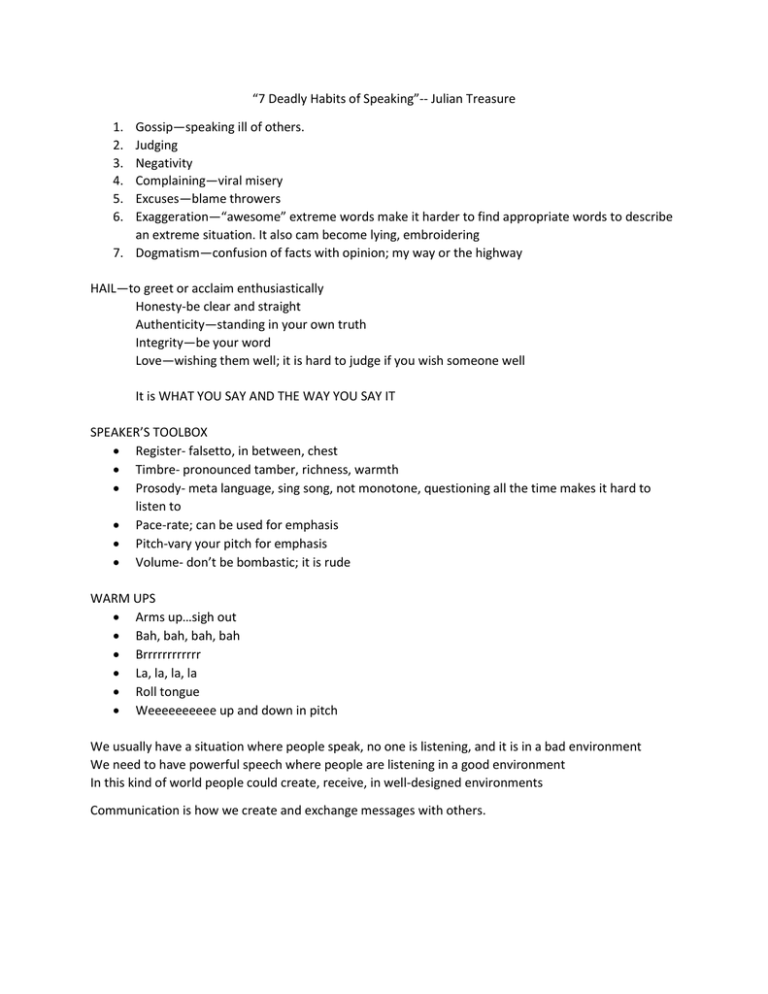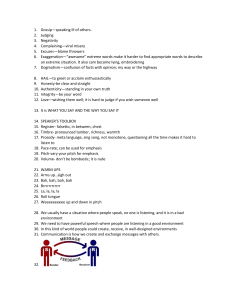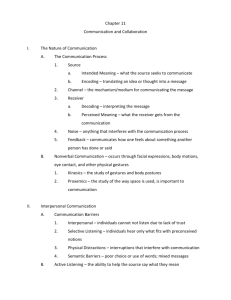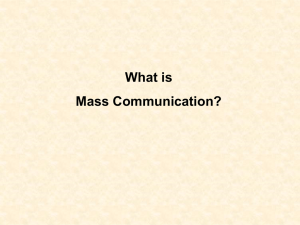“7 Deadly Habits of Speaking”-- Julian Treasure Gossip—speaking
advertisement

“7 Deadly Habits of Speaking”-- Julian Treasure 1. 2. 3. 4. 5. 6. Gossip—speaking ill of others. Judging Negativity Complaining—viral misery Excuses—blame throwers Exaggeration—“awesome” extreme words make it harder to find appropriate words to describe an extreme situation. It also cam become lying, embroidering 7. Dogmatism—confusion of facts with opinion; my way or the highway HAIL—to greet or acclaim enthusiastically Honesty-be clear and straight Authenticity—standing in your own truth Integrity—be your word Love—wishing them well; it is hard to judge if you wish someone well It is WHAT YOU SAY AND THE WAY YOU SAY IT SPEAKER’S TOOLBOX Register- falsetto, in between, chest Timbre- pronounced tamber, richness, warmth Prosody- meta language, sing song, not monotone, questioning all the time makes it hard to listen to Pace-rate; can be used for emphasis Pitch-vary your pitch for emphasis Volume- don’t be bombastic; it is rude WARM UPS Arms up…sigh out Bah, bah, bah, bah Brrrrrrrrrrrr La, la, la, la Roll tongue Weeeeeeeeee up and down in pitch We usually have a situation where people speak, no one is listening, and it is in a bad environment We need to have powerful speech where people are listening in a good environment In this kind of world people could create, receive, in well-designed environments Communication is how we create and exchange messages with others. Types of interpersonal communication: Linear: Message flows in one direction from a sender to a receiver. In all interpersonal communication models, there is always noise; meaning factors that can impede the message from being received. Interactive: There is a sender and receiver, but there are two additional factors influencing the transmission—feedback (verbal and nonverbal) and fields of experience. If field of experience is similar the ease of understanding is better. Transactional: communication is fundamentally multidirectional. The messages are exchanged through channels, jointly creating meaning. Each person equally influences the conversation. There is no perceived sender or receiver. Most interpersonal communication is transactional Impacts our relationships. It changes thoughts, behaviors, emotions, and relationships. Communication relationships I-thou competent communication welcoming respectful I-it Focuses on personal differences Refuses to accept the other’s opinions as valid Creates a distance Views the other as an object to exploit Becomes disrespectful and manipulative as it worsens, and relationship deteriorates Interpersonal Communication: Conveys: Content information-actual meaning of the words Relationship information- indicates how each person views the relationship This can create problems when perception of sender in situation is different from the receiver. How can we assure we are not sending a different message than intended? Metacommunication: Communication about how we communicate It is any message that includes information, both verbal and non-verbal, that is centrally focused on the meaning of the communication. It is about how the information is perceived. Interpersonal Communication can be: Intentional Unintentional People tend to attach meaning to nearly everything you say and do. It is impossible to not communicate. Is irreversible: Even how you answer your phone effects the rest of the conversation and can change the relationship. Once it is said, you cannot take it backFacebook posts Texts Voicemails Instagram Spoken thoughts Think before you communicate! Is dynamic When you interact with others, your communication and all that influences it (perceptions, thoughts, feelings, and emotions) is constantly in flux. The complex combination of perceptions, thoughts, moods, and emotions that fuel communication choices is constantly changing. For instance, you are overjoyed to see someone and then a few minutes later, you have nothing to say to each other. Helen Keller Became blind and deaf at 19 months old When she couldn’t hear, she stopped trying to talk Felt isolated and frustrated. She said she became a phantom. That phantom threw temper tantrums and even punched her teacher in the mouth. She learned sign language and began to feel a sense of returning thought It is a profound human need to communicate Maslow’s Hierarchy of Needs: How does interpersonal communication assist people in pursuing higher needs? Three types of goals it helps us meet: Self presentation goals-helps you to determine how you are perceived Instrumental goals-practical aims you want to achieve or tasks you want to accomplish through a particular interpersonal encounter Relationship goals-building, maintaining, or terminating bonds with others Interpersonal Competence is: Constantly communicating in ways that are appropriate Following accepted norms Effective Enables speaker to achieve goals Ethical Treats people fairly Knowing what it means is the first step in developing interpersonal communication competence. The second step is to TRANSLATE THE KNOWLEDGE INTO COMMUNICATION SKILLS Repeatable Goal directed Routinely practiced BUT… YOU HAVE TO BE MOTIVATED TO IMPROVE! Appropriateness: It matches the: Situation Relationship Cultural Expectations of how people should communicate. Self Monitoring Checking our own communication against the social norms Overemphasizing appropriateness can cause loss of freedom to express because of peer pressure or fear of people thinking you are negative. Effectiveness: Able, through communication, to accomplish interpersonal goals: self presentational instrumental relational Example of trade off: You want to go to the movies (instrumental) but your friend needs your emotional support (relational). Do you say “I’ll call you after the movie”? Or do you say, “I’ll see the movie another time—tonight Ill hang out with you”? Which choice is more competent? Ethics: The set of moral principles that govern our behavior toward others. At a minimum, we are ethically obligated to avoid intentionally hurting others through our communication. Meaning: If it hurts another person’s self esteem Expresses intolerance or hatred Intimidates or threatens another’s physical well-being Expresses violence All of the above are incompetent. To be truly ethical: Go beyond simply not doing harm. Strive to treat others with: Respect Honesty Kindness Positivity It is easy to be competent when the situation is easy and demands little of us BUT.. When we can consistently communicate competently across all situations we face; i.e. uncertain, complex, unpleasant— Only then are we truly competent communicators. Online communication competence: Email Text Instant messaging Social media posting Tons of benefits from these mediums. Meet people Maintain relationships especially with distant people Sense of community Because we use it so often ALL THE MORE REASON WE NEED TO BUILD ONLINE COMMUNICATION COMPETENCE! Match the gravity of the message with the right communication medium. Example: text messaging a friend to invite for dinner rather than show up at their job It’s quicker and less disruptive Emailing is better for dealing with certain types of conflict more time to frame your words, unlike face-to-face Online is not good for giving lengthy discussions, personal problems, or weighty relationship decisions Important news should be shared in person Don’t assume online is more efficient Matters of relationship issues or strongly emotional are handled more ethically in person or over the phone Even deciding where to meet for lunch can be faster over the phone than by text Always assume your posts are public Don’t post anything that although funny, may hurt someone else. This stuff can go viral so easily Even privacy settings won’t stop the person you sent to from forwarding. Don’t assume online is more efficient Matters of relationship issues or strongly emotional are handled more ethically in person or over the phone Even deciding where to meet for lunch can be faster over the phone than by text Always assume your posts are public Don’t post anything that although funny, may hurt someone else. This stuff can go viral so easily Even privacy settings won’t stop the person you sent to from forwarding





